Data Modeling Report: Analysis of Employee Retention in Insurance
VerifiedAdded on 2023/01/18
|8
|1266
|91
Report
AI Summary
This report presents a data modeling analysis of employee retention within an insurance company. The study investigates the high turnover rate of agents, focusing on the training program's limitations and factors contributing to employee dismissal. The research employs a positivism philosophy with a descriptive research design, utilizing a Likert scale survey administered to 51 former agents. The methodology includes data collection, analysis, and interpretation, with the anticipation of identifying correlations between professional issues, training effectiveness, and employee satisfaction. The report aims to provide actionable insights for the company to improve its hiring and retention strategies, ultimately enhancing its organizational reputation. The study covers literature review, research methodology, anticipated findings and conclusion.
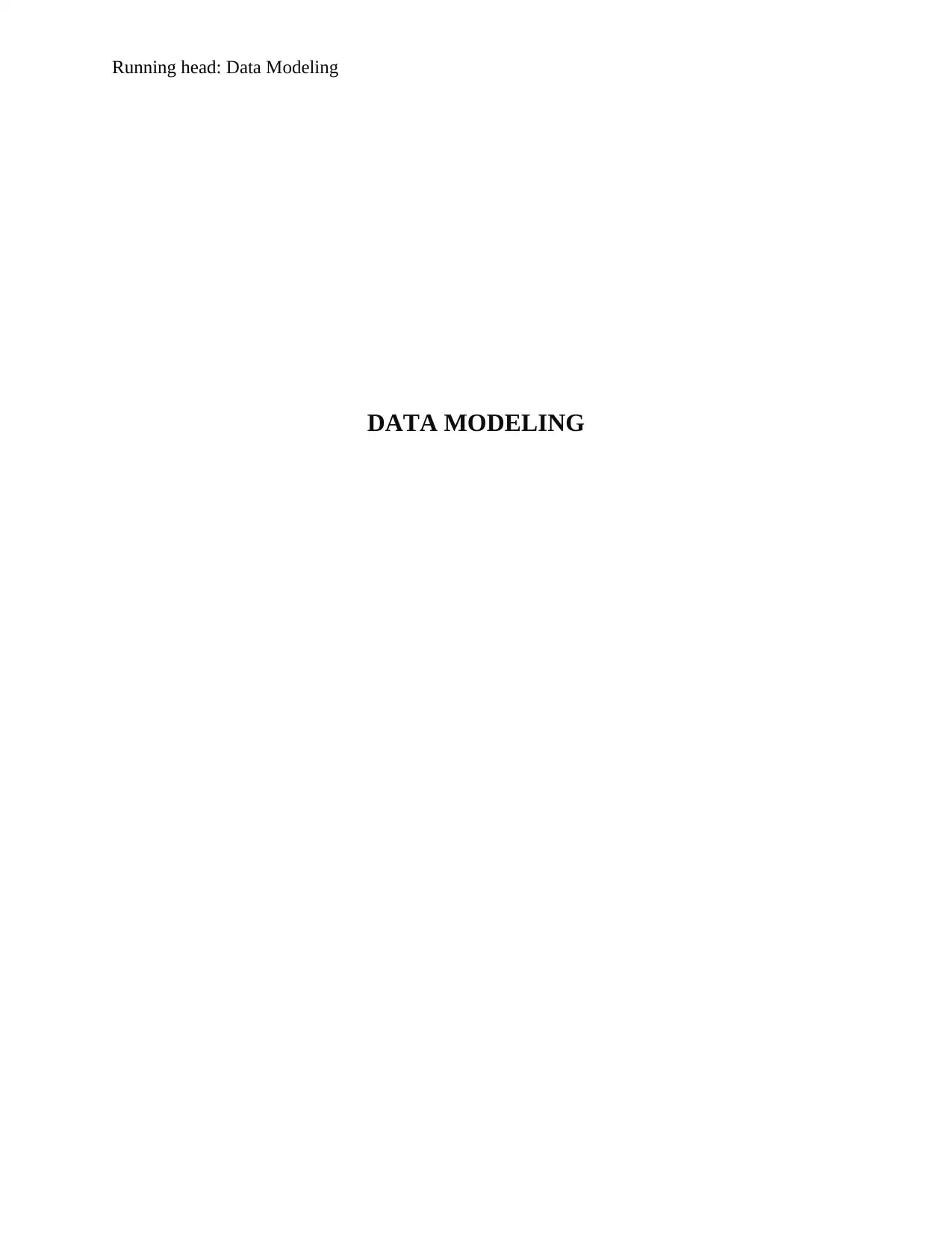
Running head: Data Modeling
DATA MODELING
DATA MODELING
Paraphrase This Document
Need a fresh take? Get an instant paraphrase of this document with our AI Paraphraser
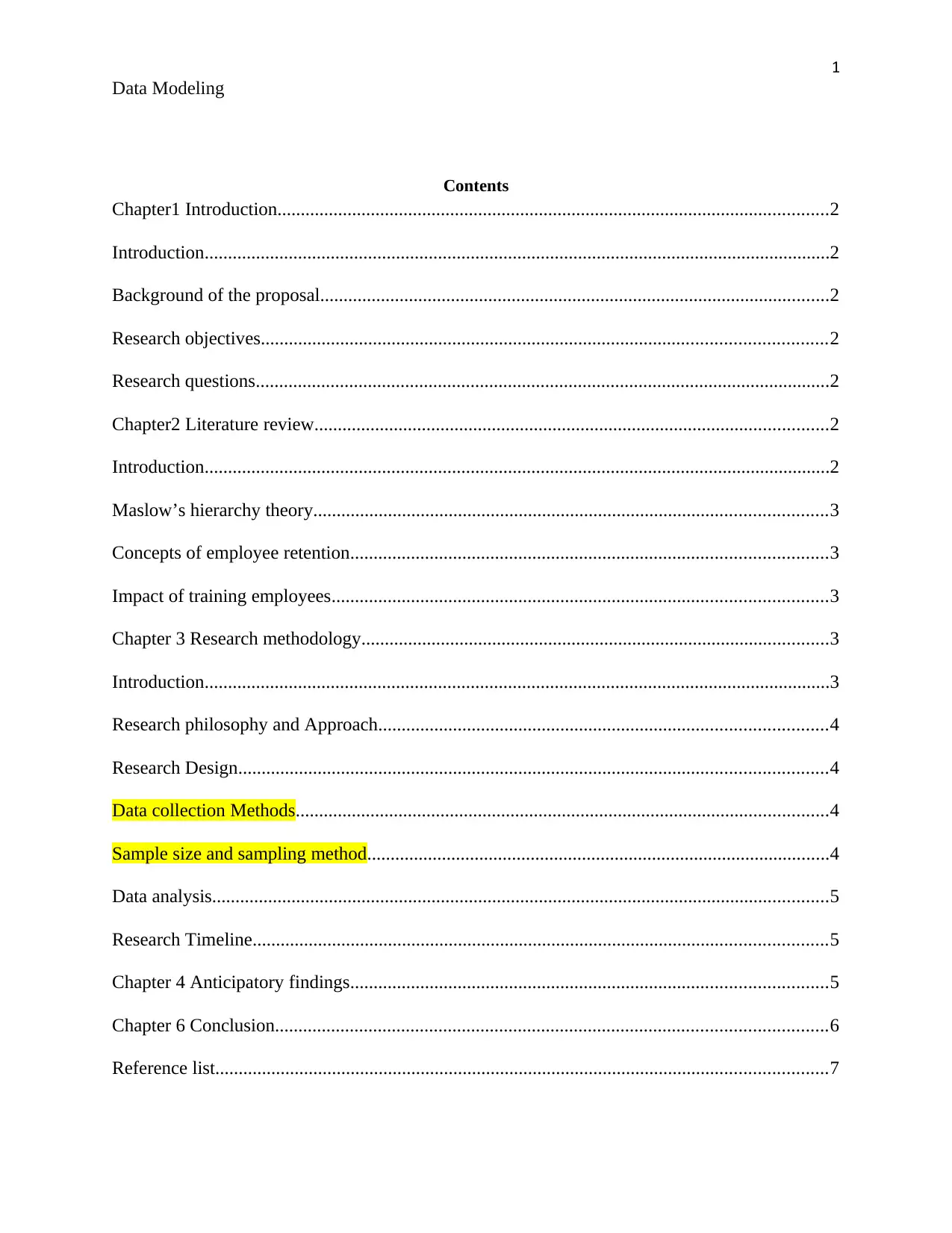
1
Data Modeling
Contents
Chapter1 Introduction......................................................................................................................2
Introduction......................................................................................................................................2
Background of the proposal.............................................................................................................2
Research objectives.........................................................................................................................2
Research questions...........................................................................................................................2
Chapter2 Literature review..............................................................................................................2
Introduction......................................................................................................................................2
Maslow’s hierarchy theory..............................................................................................................3
Concepts of employee retention......................................................................................................3
Impact of training employees..........................................................................................................3
Chapter 3 Research methodology....................................................................................................3
Introduction......................................................................................................................................3
Research philosophy and Approach................................................................................................4
Research Design..............................................................................................................................4
Data collection Methods..................................................................................................................4
Sample size and sampling method...................................................................................................4
Data analysis....................................................................................................................................5
Research Timeline...........................................................................................................................5
Chapter 4 Anticipatory findings......................................................................................................5
Chapter 6 Conclusion......................................................................................................................6
Reference list...................................................................................................................................7
Data Modeling
Contents
Chapter1 Introduction......................................................................................................................2
Introduction......................................................................................................................................2
Background of the proposal.............................................................................................................2
Research objectives.........................................................................................................................2
Research questions...........................................................................................................................2
Chapter2 Literature review..............................................................................................................2
Introduction......................................................................................................................................2
Maslow’s hierarchy theory..............................................................................................................3
Concepts of employee retention......................................................................................................3
Impact of training employees..........................................................................................................3
Chapter 3 Research methodology....................................................................................................3
Introduction......................................................................................................................................3
Research philosophy and Approach................................................................................................4
Research Design..............................................................................................................................4
Data collection Methods..................................................................................................................4
Sample size and sampling method...................................................................................................4
Data analysis....................................................................................................................................5
Research Timeline...........................................................................................................................5
Chapter 4 Anticipatory findings......................................................................................................5
Chapter 6 Conclusion......................................................................................................................6
Reference list...................................................................................................................................7
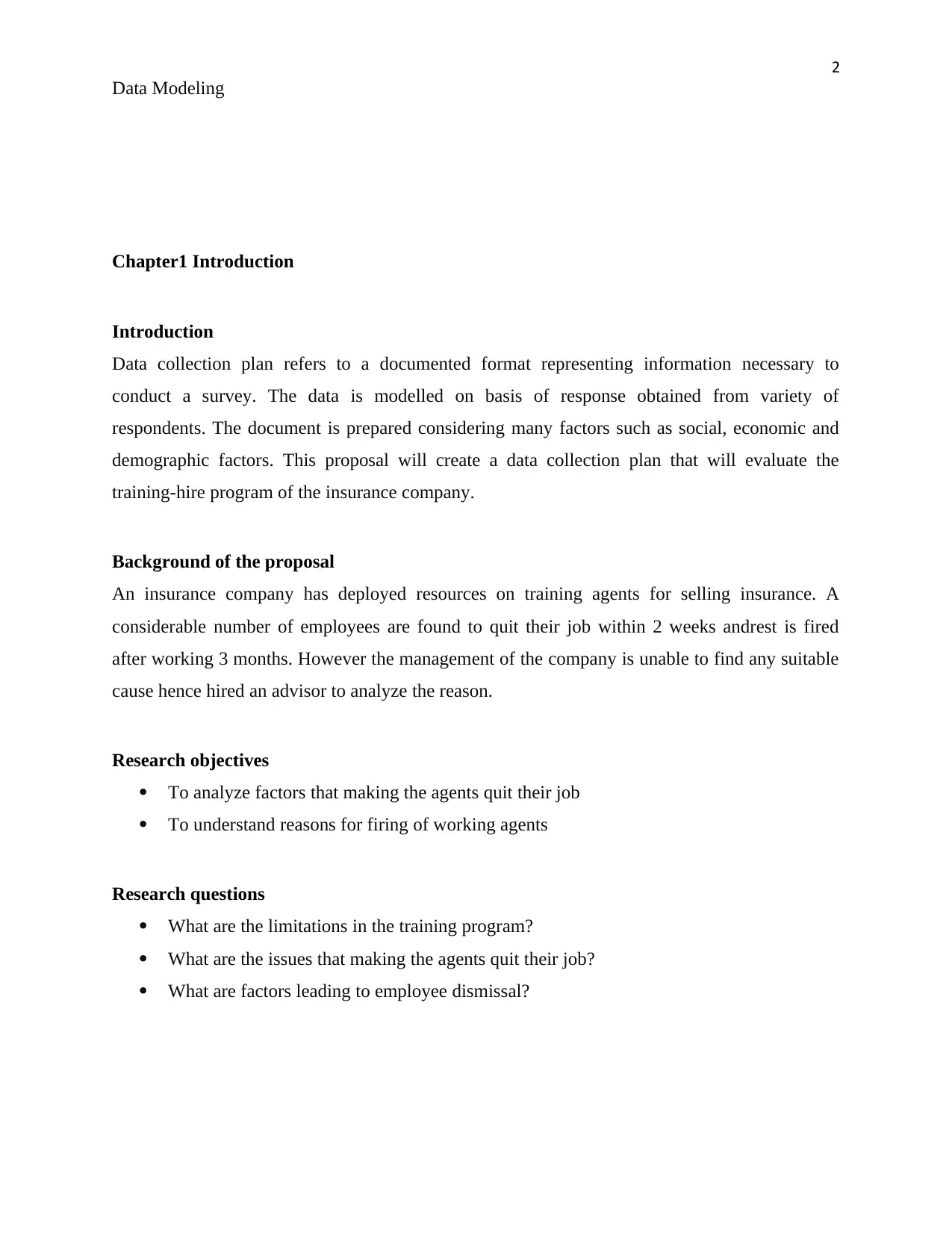
2
Data Modeling
Chapter1 Introduction
Introduction
Data collection plan refers to a documented format representing information necessary to
conduct a survey. The data is modelled on basis of response obtained from variety of
respondents. The document is prepared considering many factors such as social, economic and
demographic factors. This proposal will create a data collection plan that will evaluate the
training-hire program of the insurance company.
Background of the proposal
An insurance company has deployed resources on training agents for selling insurance. A
considerable number of employees are found to quit their job within 2 weeks andrest is fired
after working 3 months. However the management of the company is unable to find any suitable
cause hence hired an advisor to analyze the reason.
Research objectives
To analyze factors that making the agents quit their job
To understand reasons for firing of working agents
Research questions
What are the limitations in the training program?
What are the issues that making the agents quit their job?
What are factors leading to employee dismissal?
Data Modeling
Chapter1 Introduction
Introduction
Data collection plan refers to a documented format representing information necessary to
conduct a survey. The data is modelled on basis of response obtained from variety of
respondents. The document is prepared considering many factors such as social, economic and
demographic factors. This proposal will create a data collection plan that will evaluate the
training-hire program of the insurance company.
Background of the proposal
An insurance company has deployed resources on training agents for selling insurance. A
considerable number of employees are found to quit their job within 2 weeks andrest is fired
after working 3 months. However the management of the company is unable to find any suitable
cause hence hired an advisor to analyze the reason.
Research objectives
To analyze factors that making the agents quit their job
To understand reasons for firing of working agents
Research questions
What are the limitations in the training program?
What are the issues that making the agents quit their job?
What are factors leading to employee dismissal?
⊘ This is a preview!⊘
Do you want full access?
Subscribe today to unlock all pages.

Trusted by 1+ million students worldwide

3
Data Modeling
Chapter2 Literature review
Introduction
Employee retention becomes a challenging task for many organizations when the job is target
oriented. In order to fetch a good profit the employers overburden the employees with targets
(Baesens et al., 2016). Insurance companies should focus more on improving communication
skills other than achieving targets.
Maslow’s hierarchy theory
The theory states that employers need to pay attention to the health and job security of the
employees. When the employees feel secured to work in a healthy environment, they give their
best effort in job that place them advanced position (Ajunwa et al., 2017).
Concepts of employee retention
An organization can retain their employees for longer period if they understand the basic
requirements of employees(Zelizer, 2017). Motivating employees reflects in work productivity
and employees perform better when they are more experienced.
Impact of training employees
On job training helps the employees to know the work environment. Trainings improve skills
and for insurance companies communication skills plays significant role. The insurance company
could assign small targets initially that would likely to increase based on performance (Reina et
al., 2018).
Chapter 3 Research methodology
Introduction
Research methodology serves as a framework of data collection techniques that will be
appropriate with the chosen topic. Research methodology is a systematic study that will be
Data Modeling
Chapter2 Literature review
Introduction
Employee retention becomes a challenging task for many organizations when the job is target
oriented. In order to fetch a good profit the employers overburden the employees with targets
(Baesens et al., 2016). Insurance companies should focus more on improving communication
skills other than achieving targets.
Maslow’s hierarchy theory
The theory states that employers need to pay attention to the health and job security of the
employees. When the employees feel secured to work in a healthy environment, they give their
best effort in job that place them advanced position (Ajunwa et al., 2017).
Concepts of employee retention
An organization can retain their employees for longer period if they understand the basic
requirements of employees(Zelizer, 2017). Motivating employees reflects in work productivity
and employees perform better when they are more experienced.
Impact of training employees
On job training helps the employees to know the work environment. Trainings improve skills
and for insurance companies communication skills plays significant role. The insurance company
could assign small targets initially that would likely to increase based on performance (Reina et
al., 2018).
Chapter 3 Research methodology
Introduction
Research methodology serves as a framework of data collection techniques that will be
appropriate with the chosen topic. Research methodology is a systematic study that will be
Paraphrase This Document
Need a fresh take? Get an instant paraphrase of this document with our AI Paraphraser
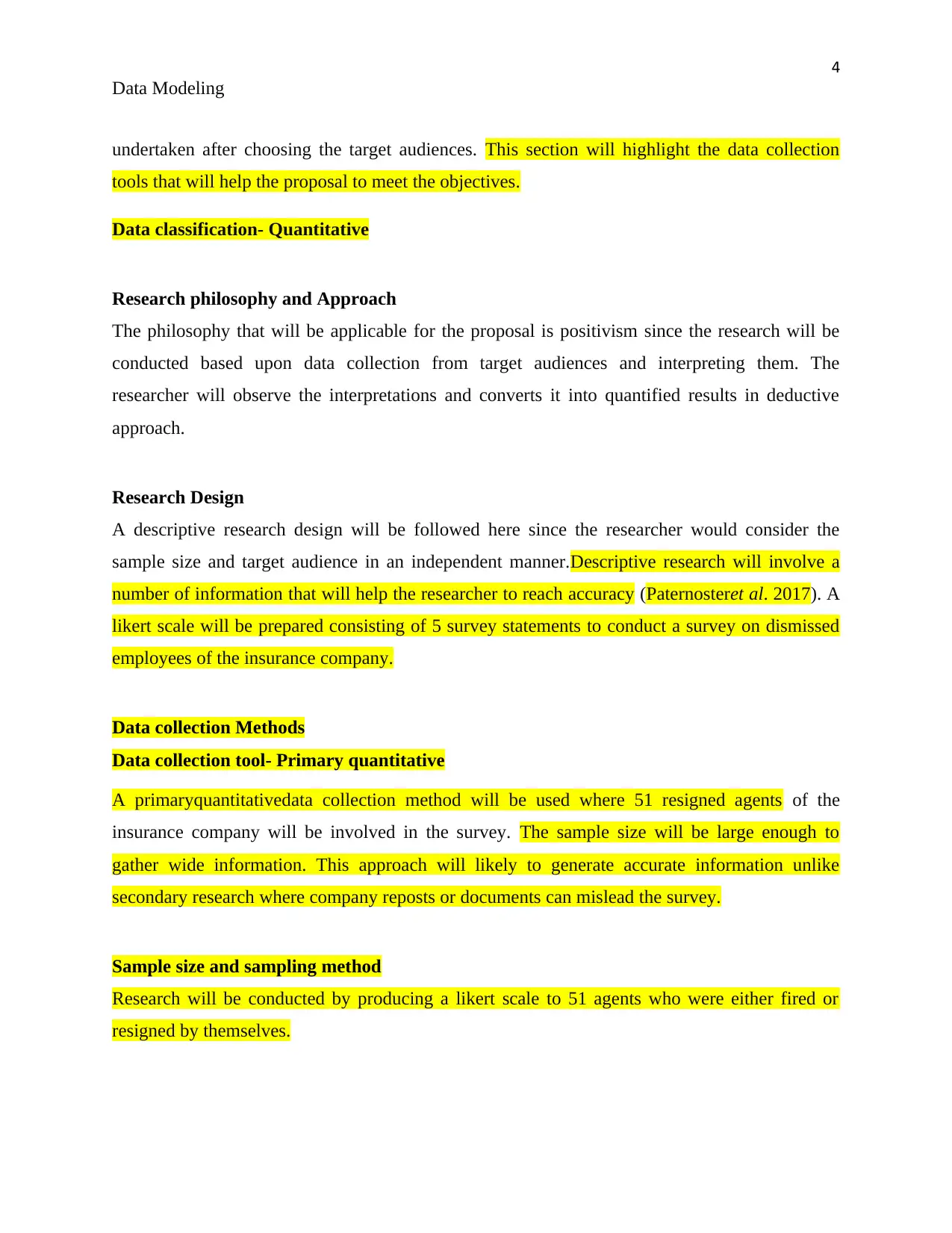
4
Data Modeling
undertaken after choosing the target audiences. This section will highlight the data collection
tools that will help the proposal to meet the objectives.
Data classification- Quantitative
Research philosophy and Approach
The philosophy that will be applicable for the proposal is positivism since the research will be
conducted based upon data collection from target audiences and interpreting them. The
researcher will observe the interpretations and converts it into quantified results in deductive
approach.
Research Design
A descriptive research design will be followed here since the researcher would consider the
sample size and target audience in an independent manner.Descriptive research will involve a
number of information that will help the researcher to reach accuracy (Paternosteret al. 2017). A
likert scale will be prepared consisting of 5 survey statements to conduct a survey on dismissed
employees of the insurance company.
Data collection Methods
Data collection tool- Primary quantitative
A primaryquantitativedata collection method will be used where 51 resigned agents of the
insurance company will be involved in the survey. The sample size will be large enough to
gather wide information. This approach will likely to generate accurate information unlike
secondary research where company reposts or documents can mislead the survey.
Sample size and sampling method
Research will be conducted by producing a likert scale to 51 agents who were either fired or
resigned by themselves.
Data Modeling
undertaken after choosing the target audiences. This section will highlight the data collection
tools that will help the proposal to meet the objectives.
Data classification- Quantitative
Research philosophy and Approach
The philosophy that will be applicable for the proposal is positivism since the research will be
conducted based upon data collection from target audiences and interpreting them. The
researcher will observe the interpretations and converts it into quantified results in deductive
approach.
Research Design
A descriptive research design will be followed here since the researcher would consider the
sample size and target audience in an independent manner.Descriptive research will involve a
number of information that will help the researcher to reach accuracy (Paternosteret al. 2017). A
likert scale will be prepared consisting of 5 survey statements to conduct a survey on dismissed
employees of the insurance company.
Data collection Methods
Data collection tool- Primary quantitative
A primaryquantitativedata collection method will be used where 51 resigned agents of the
insurance company will be involved in the survey. The sample size will be large enough to
gather wide information. This approach will likely to generate accurate information unlike
secondary research where company reposts or documents can mislead the survey.
Sample size and sampling method
Research will be conducted by producing a likert scale to 51 agents who were either fired or
resigned by themselves.
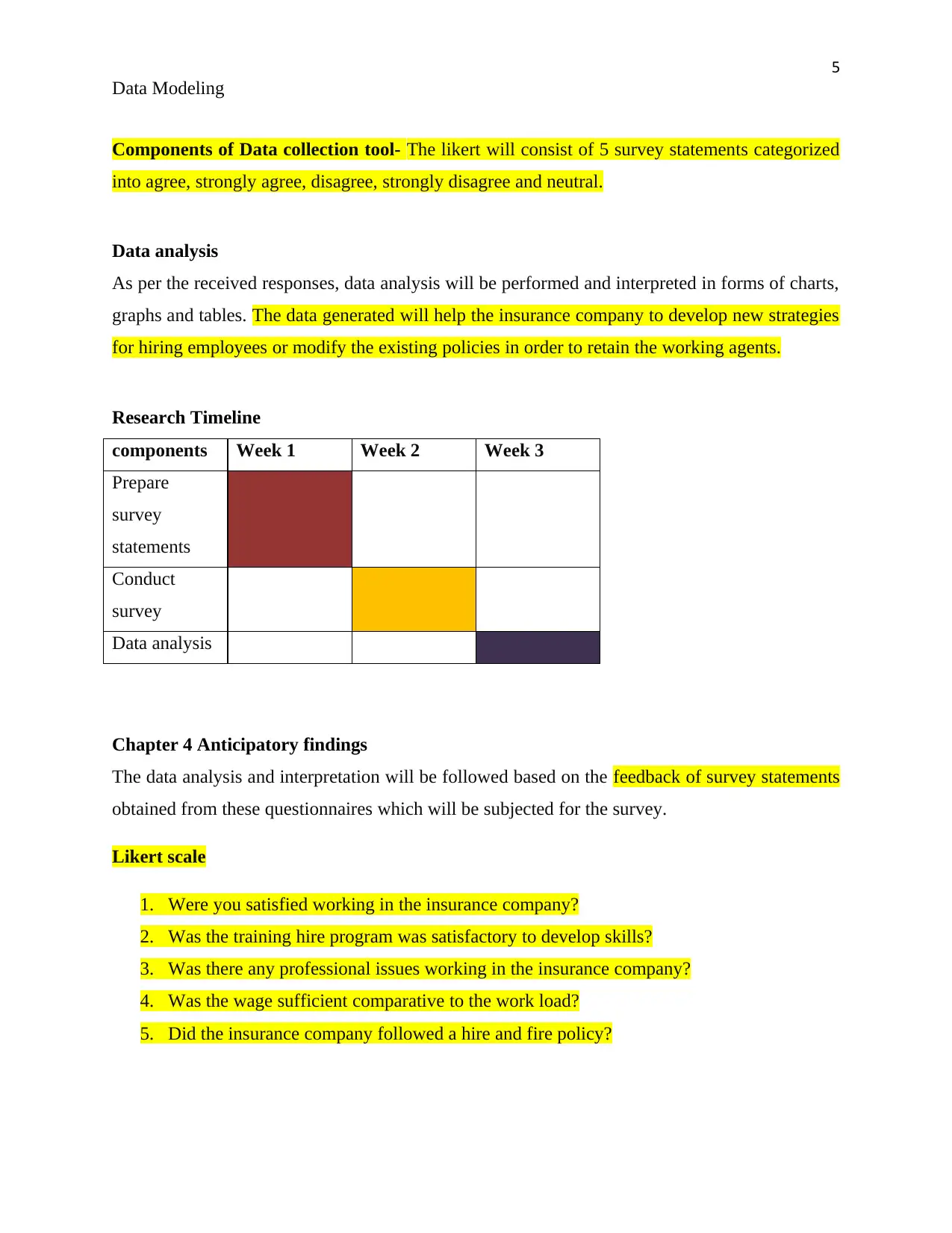
5
Data Modeling
Components of Data collection tool- The likert will consist of 5 survey statements categorized
into agree, strongly agree, disagree, strongly disagree and neutral.
Data analysis
As per the received responses, data analysis will be performed and interpreted in forms of charts,
graphs and tables. The data generated will help the insurance company to develop new strategies
for hiring employees or modify the existing policies in order to retain the working agents.
Research Timeline
components Week 1 Week 2 Week 3
Prepare
survey
statements
Conduct
survey
Data analysis
Chapter 4 Anticipatory findings
The data analysis and interpretation will be followed based on the feedback of survey statements
obtained from these questionnaires which will be subjected for the survey.
Likert scale
1. Were you satisfied working in the insurance company?
2. Was the training hire program was satisfactory to develop skills?
3. Was there any professional issues working in the insurance company?
4. Was the wage sufficient comparative to the work load?
5. Did the insurance company followed a hire and fire policy?
Data Modeling
Components of Data collection tool- The likert will consist of 5 survey statements categorized
into agree, strongly agree, disagree, strongly disagree and neutral.
Data analysis
As per the received responses, data analysis will be performed and interpreted in forms of charts,
graphs and tables. The data generated will help the insurance company to develop new strategies
for hiring employees or modify the existing policies in order to retain the working agents.
Research Timeline
components Week 1 Week 2 Week 3
Prepare
survey
statements
Conduct
survey
Data analysis
Chapter 4 Anticipatory findings
The data analysis and interpretation will be followed based on the feedback of survey statements
obtained from these questionnaires which will be subjected for the survey.
Likert scale
1. Were you satisfied working in the insurance company?
2. Was the training hire program was satisfactory to develop skills?
3. Was there any professional issues working in the insurance company?
4. Was the wage sufficient comparative to the work load?
5. Did the insurance company followed a hire and fire policy?
⊘ This is a preview!⊘
Do you want full access?
Subscribe today to unlock all pages.

Trusted by 1+ million students worldwide
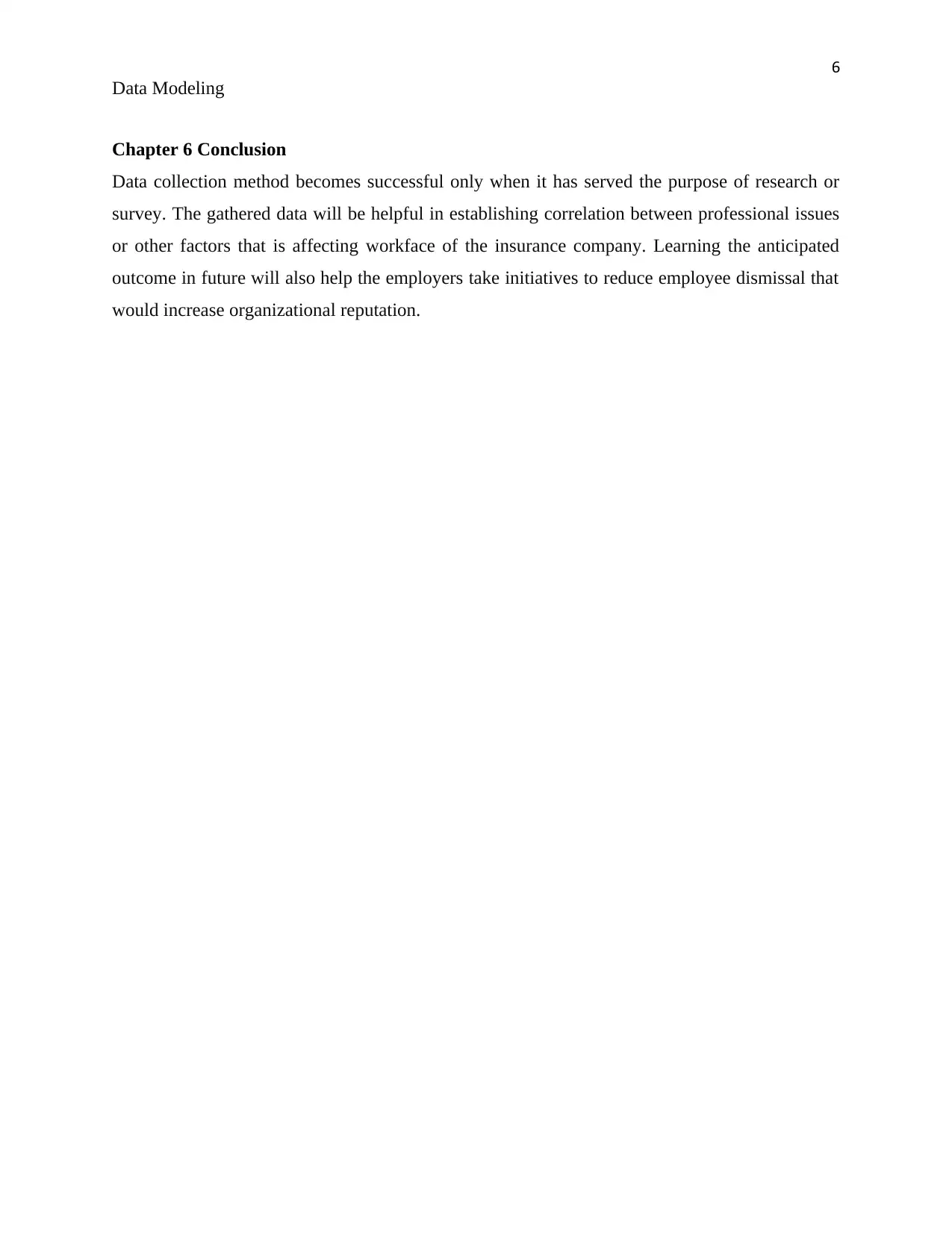
6
Data Modeling
Chapter 6 Conclusion
Data collection method becomes successful only when it has served the purpose of research or
survey. The gathered data will be helpful in establishing correlation between professional issues
or other factors that is affecting workface of the insurance company. Learning the anticipated
outcome in future will also help the employers take initiatives to reduce employee dismissal that
would increase organizational reputation.
Data Modeling
Chapter 6 Conclusion
Data collection method becomes successful only when it has served the purpose of research or
survey. The gathered data will be helpful in establishing correlation between professional issues
or other factors that is affecting workface of the insurance company. Learning the anticipated
outcome in future will also help the employers take initiatives to reduce employee dismissal that
would increase organizational reputation.
Paraphrase This Document
Need a fresh take? Get an instant paraphrase of this document with our AI Paraphraser
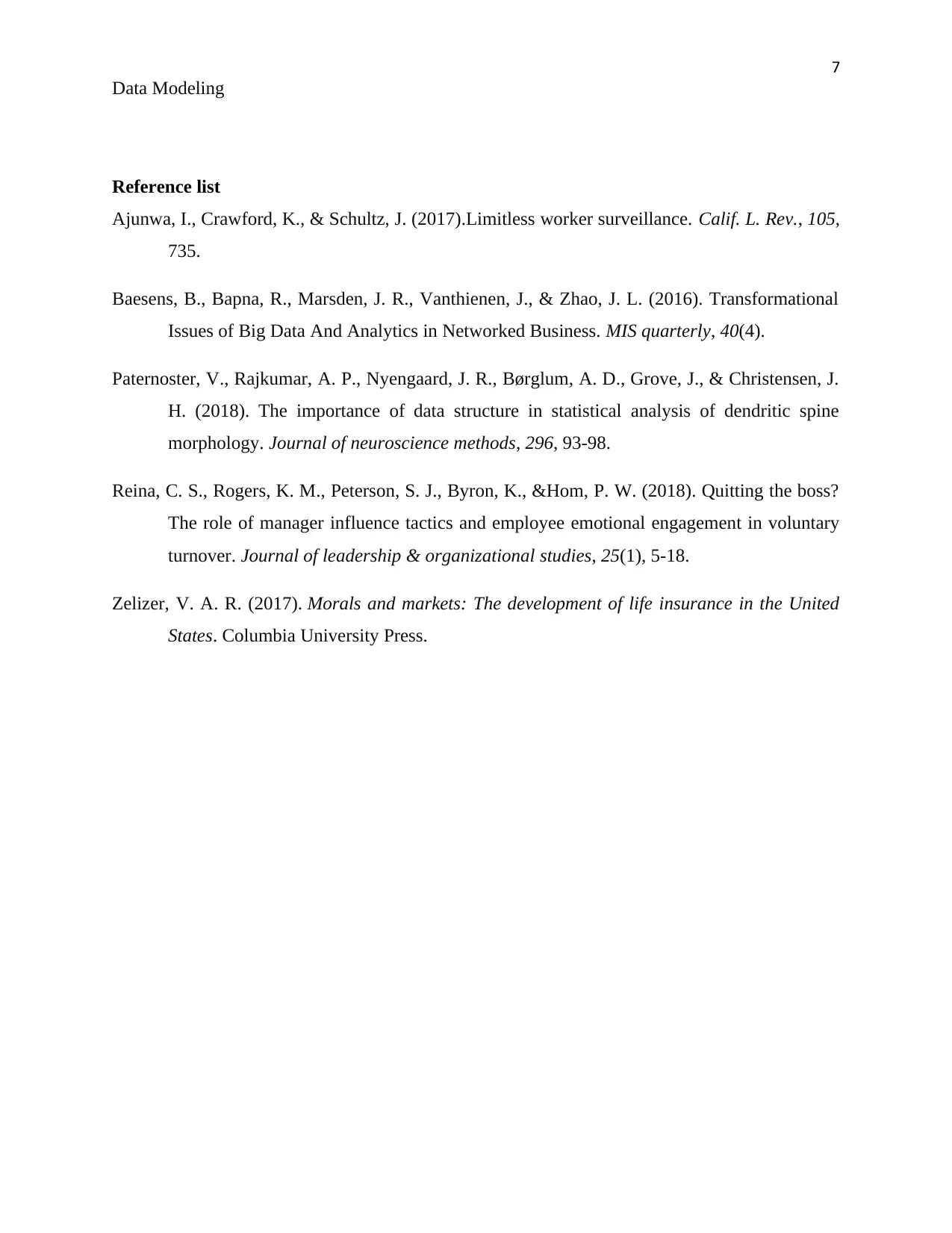
7
Data Modeling
Reference list
Ajunwa, I., Crawford, K., & Schultz, J. (2017).Limitless worker surveillance. Calif. L. Rev., 105,
735.
Baesens, B., Bapna, R., Marsden, J. R., Vanthienen, J., & Zhao, J. L. (2016). Transformational
Issues of Big Data And Analytics in Networked Business. MIS quarterly, 40(4).
Paternoster, V., Rajkumar, A. P., Nyengaard, J. R., Børglum, A. D., Grove, J., & Christensen, J.
H. (2018). The importance of data structure in statistical analysis of dendritic spine
morphology. Journal of neuroscience methods, 296, 93-98.
Reina, C. S., Rogers, K. M., Peterson, S. J., Byron, K., &Hom, P. W. (2018). Quitting the boss?
The role of manager influence tactics and employee emotional engagement in voluntary
turnover. Journal of leadership & organizational studies, 25(1), 5-18.
Zelizer, V. A. R. (2017). Morals and markets: The development of life insurance in the United
States. Columbia University Press.
Data Modeling
Reference list
Ajunwa, I., Crawford, K., & Schultz, J. (2017).Limitless worker surveillance. Calif. L. Rev., 105,
735.
Baesens, B., Bapna, R., Marsden, J. R., Vanthienen, J., & Zhao, J. L. (2016). Transformational
Issues of Big Data And Analytics in Networked Business. MIS quarterly, 40(4).
Paternoster, V., Rajkumar, A. P., Nyengaard, J. R., Børglum, A. D., Grove, J., & Christensen, J.
H. (2018). The importance of data structure in statistical analysis of dendritic spine
morphology. Journal of neuroscience methods, 296, 93-98.
Reina, C. S., Rogers, K. M., Peterson, S. J., Byron, K., &Hom, P. W. (2018). Quitting the boss?
The role of manager influence tactics and employee emotional engagement in voluntary
turnover. Journal of leadership & organizational studies, 25(1), 5-18.
Zelizer, V. A. R. (2017). Morals and markets: The development of life insurance in the United
States. Columbia University Press.
1 out of 8
Related Documents
Your All-in-One AI-Powered Toolkit for Academic Success.
+13062052269
info@desklib.com
Available 24*7 on WhatsApp / Email
![[object Object]](/_next/static/media/star-bottom.7253800d.svg)
Unlock your academic potential
Copyright © 2020–2025 A2Z Services. All Rights Reserved. Developed and managed by ZUCOL.





